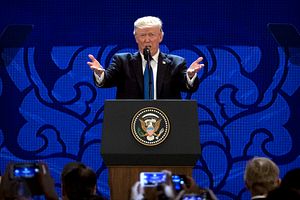In a cavernous Manila exhibition hall, flooded with light, U.S. President Donald Trump stood flanked by members of his national security team to deliver remarks to the press in November 2017. Joking that the White House press corps would need a day to recover from his first Asia trip – which covered five countries – the president observed, “It’s been an incredible 12 days. I’ve made a lot of friends at the highest levels.”
After intense public back-and-forth over Trump’s attendance at the 2017 East Asia Summit in the Philippines, he departed immediately following the leaders’ lunch, but before delivering official remarks. Officials cited a tight schedule, noting that the summit was running behind. Then-Secretary of State Rex Tillerson was left behind to speak in the president’s stead.
Nearly one year later, onlookers are still seeking clarity about the Trump administration’s Indo-Pacific strategy. Characterized by a newly declared strategic competition with China, “fair and reciprocal” trade deals, a free and open Indo-Pacific region, and increased emphasis on the Quad – a diplomatic grouping of Australia, India, Japan, and the United States – Trump’s approach is in some respects a predictable evolution of U.S. regional policy, while in other ways deeply disruptive. The administration’s ability to reconcile these competing forces into affirmative policy solutions will be the single largest factor that determines its relative success.
Undoubtedly, Trump’s business-like focus on interpersonal relationships has dramatically altered the landscape of the United States’ engagement with Asia. His emphasis on cultivating direct ties with foreign leaders upended conventional “bottom-up” bureaucratic models and led to fast decision-making with far-reaching ramifications – the president’s June Singapore Summit with North Korean Chairman Kim Jong Un being the most noteworthy example.
But Trump’s love-affair with Asia was far from assured during his candidacy.

































